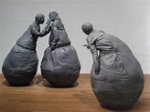Airport, please! heads to the beautiful Petit Palais, in Paris, for Ugo Rondinone’s exhibit
PETIT PALAIS
Every autumn since 2015, the Petit Palais, located at Avenue Winston Churchill, in the Eighth Arrondissement, has invited contemporary artists to exhibit alongside its permanent collection. This year, the Swiss artist, Ugo Rondinone, will present an exclusive exhibition opening October 18. The title is:
THE WATER IS A POEM
UNWRITTEN BY THE AIR
NO. THE EARTH IS A POEM
UNWRITTEN BY THE FIRE
This exhibition was organized by Juliette Singer, Chief curator, in charge of contemporary projects at the Petit Palais and Erik Verhagen, Professor of contemporary art history, Université polytechnique Hauts-de-France
Built for the 1900 Exposition Universelle, the Petit Palais now houses the City of Paris Museum of Fine Arts (Musée des beaux-arts de la ville de Paris). Located across from the Grand Palais on the former Avenue Nicolas II, today Avenue Winston-Churchill, the other façades of the building face the Seine and the avenue de Champs-Elysees.
The Petit Palais is one of fourteen museums of the City of Paris that have been incorporated since January 2013 in the public corporation Paris Musees. It has been listed since 1975 as a historic monument by the Ministry of Culture.
UGO RONDINONE
Ugo Rondinone (Swiss, b.1964) is an installation artist best known for his circular spray paintings and video environments that convey a sense of melancholy and alienation. Born in Brunnen, Rondinone graduated from the Hochschule für angewandte Kunst in Vienna in 1990. Starting in the 1990s, he has produced a series of circular paintings that are titled by number and resemble Kenneth Noland’s target paintings. Rondinone works with different media, such as photography, video, sculpture, and drawing, and often appropriates phrases from literature and popular culture. For his series I Don’t Live Here Anymore (1995-1998) Rondinone digitally manipulated photographs of fashion models in suggestive poses, so that his facial features replace those of the models.
Many of his works involve signage, such as the rainbow colored sculpture Hell, Yes! (2001), which stood on the facade of the New Museum in New York. By contrast, the installation Roundelay (2003) sets a melancholic tone with six video projections of a man and woman walking through the streets of Paris; the spatial distortions and score by composer Philip Glass evoke alienation in an urban environment. Rondinone has held solo exhibitions at several museums around the world, including the Centre Georges Pompidou in Paris, the Museum of Contemporary Art in Sydney, and the Museo de Arte Contemporáneo de Castilla in León, Spain. In 2007, he represented Switzerland at the 52nd Venice Biennale. He currently lives and works in New York.
Ugo Rondinone is one of the most important contemporary Swiss artists of his generation. Working as a painter, sculptor, and photographer, he is most concerned with the perception of space and time and how humanity interacts with its natural environment. In 1996 Rondinone represented Switzerland at the São Paulo Biennale and in 2007, together with fellow Swiss creator Urs Fischer, he built an impressive large-scale installation at the 52nd Venice Biennale.
Rondinone began elaborating his series of monumental mountain sculptures in 2011, when commissioned by the Nevada Museum of Art in Reno in the United States to create a site-specific public installation. With the aim to begin a new chapter in the history of Land Art, an art movement that emerged towards the end of the 1960s and is characterized by artistic interventions in nature, he remained indebted to his historical forebears, while being simultaneously influenced by Pop Art and comic culture. By stacking between two to six huge boulders of various shapes painted in Day-Glo colours, he creates giant rocky spires that protrude from the landscape. Reminiscent of the naturally formed hoodoos in the deserts of North America, but also of the age-old spiritual practise of piling stones, these sculptures pose a stark contrast to their surroundings.
https://www.ubs.com/global/en/our-firm/art/2021/mountain.html
ermatingen mountain is a unique sculpture commissioned by the UBS Art Collection. The artist was inspired by the beautiful landscape surrounding the Wolfsberg – UBS Center for Education and Dialogue in Ermatingen, Switzerland. By playing on our perception of scale – the piles look small from a distance, but huge when close-by – the artist elevates the surrounding landscape and invites us to broaden our perspective. He wants to produce a democratic art, that everybody can relate to and share. Overwhelming and powerful, yet balanced and meditative, Rondinone’s ‘Mountains’ highlight the contrast between the organic and constructed, between nature and civilisation.
Rondinone’s work has sharpened our awareness and appreciation of the natural environment, it recollects the mysterious legend of Stonehenge and makes us question our perception of scale, the artificial and the real. It is the perfect reflection of the current state of the world, our concerns with the threat to the environment and the mysteries of the time in which we live.
























































































